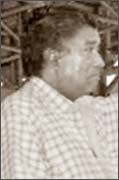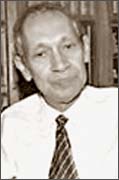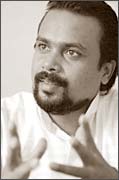|
A post-mortem:
Victory march and glancing way forward
by Raja Goonaratne
 |
 |
 |
 |
| S. L. Gunasekara |
H. L. De Silva |
Gomin Dayasiri |
Wimal Weerawansa |
Sri Lanka’s separatist-terrorism has now come to a definite end with
the elimination of LTTE leader Velupillai Piribaharan and his terror
cohorts.
This is an unprecedented victory which has created an indelible mark
in the history of our nation. The next chapter of `Mahavamsa’; the Great
Chronicle of our nation will speak in volumes the gallantry and bravado
of our war heroes. Their dedication, sacrifices, and perseverance never
wasted in vain.
In brief soldiers’ task is now over. What next? It is the question
that is being raised at every quarter at this juncture. The objective of
this brief article is to look back the way that our nation strove up to
this historical triumph and to analyze the uphill task that lies ahead
of our nation.
The history of the separatist-terrorism spearheaded by the LTTE is
more than three decades old. The LTTE turned on its killing machine by
assassinating Mr. Alfred Duraiyappah, the Mayor of Jaffna in 1975.
From that day up to 18th of May 2009, LTTE’s killing machine worked
unabatedly taking the lives of hundreds of thousands of young-old,
rich-poor, educated-uneducated, clergy and lay people in this country
belonging to all ethnic groups such as Tamils, Muslims and Sinhalese.
All successive governments led by both UNP and SLFP attempted umpteen
times to deal with LTTE terrorism but all those attempts ended opening a
new window for LTTE to regroup, thus paving way for its growth and
recognition both locally and internationally.
Consequently, LTTE grew faster creating a massive web of connections.
They found comfortable affinity with diverse groups of people in many
parts of the world including premiers, presidents, parliamentarians,
corporate magnates, arm-dealers, drug-smugglers, war-lords, NGOs, INGOs,
political parties and what not. The end result of all those is the birth
of the world most ruthless terrorist outfit from this land.
Both the benefactors and beneficiaries of LTTE’s separatist terrorism
portrayed it as an invincible force. At times there were conflict
resolution gurus in the government circles who advised the then
governments not to `play’ with LTTE.
There were peace facilitators and mediators also who facilitated only
terrorism and separatism. Especially, for some governments in the west,
Piribaharan was their `darling terrorist’ while Osama bin Laden is
`villain-terrorist’.
This dichotomy that they have created can be easily understood
because Piribaharan was the `darling agent’ of the western colonizers
and imperialism. So what he was doing was what exactly those western
powers wanted to achieve during the colonial periods but failed due to
the sacrifices of our brave forefathers.
In the above backdrop, the southern polity had gone astray as to what
was to be done to stop the country being divided.
The common patriotic man in the south had been compelled to believe
that the only solution to LTTE terrorism was division or near-division
of the country. Most of the major political parties and their rank and
file too took the same view.
In short, the collective consciousness of the entire nation had been
turned upside down and the entire society had been made impotent,
demoralized and dispirited by the powerful forces that supported the
separatist-terrorism in Sri Lanka. Therefore this victory did not come
as a sudden flight.
First Phase
In that context, what was to be done in the first place was to
re-inject the patriotism into the common man and to reawaken the
collective consciousness of the southern polity. That is the first phase
of the victory march. This first phase of victory march started long
before Mavil Aru sluice gates were closed by LTTE.
Accordingly, the patriotic forces were gathered and united under one
banner; the Lion Flag. For that there were not many actors as seen
today. A few patriotic organisations such as Patriotic National Movement
(PNM) led by sheer dedicated young political leaders such as Wimal
Weerawansa, its Chairman Dr. Gunadasa Amarasekera, a few young
university academics and some professionals, few brave Buddhist monks in
the calibre of Ven. Elle Gunawansa thera, Ven. Bengamuwe Nalaka thera,
Ven. Omare Kashyapa thera and Ven. Athuraliye Rathana thera, and some
local NGOs worked tirelessly touring the entire Island addressing the
masses.
Also, our troops who had been zeroed to the ground in every respect
by the then UNP government too had to be reawakened and reinvigorated.
For that another organization was established namely Manel Mal Movement
under the chairmanship of Mr. S. L. Gunasekara; one of the most leading
patriotic legal professionals in Sri Lanka.
They visited military bases and camps and their needs were taken care
of and provided. Some even derided our efforts and said that we were
trying to create a niche in the forces for political gains.
Also, at that time the people living in the villages threatened by
LTTE terrorism were fleeing and that too had to be stopped. They needed
to be convinced of the importance of their stay in those villages.
I still remember the words uttered by the resident Buddhist monk in
“Kadawathmaduwa” village on our visit to there. This village is located
in the east near Thoppigala. He said Wimal Weerawansa was the only
political leader who had visited that village up to that date.
At the same time many other battles were fought in various other
forums to make sure that no space for LTTE to breathe was left
unattended. Especially, the legal battles to stop granting ISGA and PTOM
to LTTE and demerger of North-East provinces are significant milestones
in the first phase of the victory march.
All patriotic people should be grateful and remember for ever the
names of legal luminaries such as Gomin Dayasiri, S. L. Gunesekara and
late H. L. De Silva who fought in the Law Courts indefatigably driven by
their sheer love for the motherland to save it being divided at the hand
of unscrupulous political maneuvering. Had not those legal measures were
taken, LTTE would have by now declared an independent state within Sri
Lanka.
We also initiated diverse other actions to educate the citizenry on
crucial matters such as Norway’s facilitation role, federalism and
imperialist hand in the LTTE separatism etc.
In one instance, when I indicated my desire to present a research
paper to the Board members of my faculty on Norway’s role in Sri Lanka,
some narrow minded and insular `academics’ in the university vehemently
objected saying that it was political. Such was the mentality of the
country’s top educators at that time.
However I managed to present the paper and convinced them that LTTE
got arms training in military camps of a Scandinavian country and also
LTTE had acquired water scooters which were proved correct as our forces
captured several water scooters from Mullaitivu area later.
Those academics never stopped there and soon after my presentation, I
got a text message to my mobile threatening me. Those villainous
elements still linger albeit wearing a different mask. Some have already
got into the victory wagon.
Second phase
The second phase of the victory march was to engineer the change of
Government. The then UNP government led by Ranil Wickremesinghe was
nothing but a docile slave to the west and its local allies and agents.
It is during that time the ceasefire agreement; the most ignominious
document in the history of this nation was signed between the LTTE and
the government.
The government had no clear direction or vision on any nationally
important issues. The panacea for any evil to them was the prescription
recommended either by their masters in the western governments or Norway
and IMF. The nation was leading towards a great peril in every respect.
The only way of saving the country was to change the government and
that was engineered forming UPFA under which all patriotic forces were
gathered to face the general election.
A great deal of work in that phase too was naturally fallen onto the
patriotic forces. We visited every village and addressed the political
meetings being ourselves organized as “Jathika Sanvidana Ekamuthuwa”.
I was one of the on-stage speakers in that general election and I
together with Prof. Granwille Dharmawardene, Prof. W. Weeraratne and
Prof. Walter Marasinghe addressed all pocket meetings with President
Mahinda Rajapaksa in his electorate and after the election he became the
Prime Minister of UPFA Government.
Although the UPFA won a comfortable victory nothing much could be
achieved in defeating separatist terrorism due to the fact that the then
President was overtaken and over dominated by the peace-merchants, human
rights industry and federalist gurus.
Third phase
In this context, the patriotic forces felt that it was extremely
necessary to change the then existing political leadership. The third
phase of the victory march began with the presidential election and how
presidential election came prematurely was part of the history that
everybody is aware of.
It is also of common knowledge that although the then Prime Minister
Mahinda Rajapaksa was nominated as the presidential candidate of UPFA,
the major constituent party of the UPFA and its rank and file played
only a lackadaisical role in that election. So again, it is the
patriotic forces led by PNM and few such organisations which came
forward to muster the support for the UPFA presidential candidate.
They worked round the clock tirelessly without expecting any benefit
to make him the leader of this country. The PNM organised meetings round
the country to convince the masses about the danger that our nation
would face unless patriotic leader was not elected.
In this backdrop, they did not waste a minute and went around the
country taking our message to each and every household because all
anti-national and treacherous forces had joined hands both locally and
internationally to stop the forward march of the patriotic forces
winning that election.
The depth and the width of that vigorous and rigorous election
campaign can be understood in terms of the election meetings addressed
by its Secretary Weerawansa. The third phase came to a logical end by
winning the presidential election and Prime Minister Rajapaksa
enthroning as the fifth Executive President of the country.
What happened thereafter was not very rosy either. There were
instances that peace-merchants and federalist gurus playing their old
role trying to divert the political leadership from making a firm stance
on the LTTE separatist-terrorism. As usual, a new round of peace talks
started between the LTTE and the government.
The first peace talks after the election of President Rajapaksa began
in February, 2006 in Switzerland. The writer also participated as a
member of an independent observer team which included a dentist Dr.
Wasantha Bandara, popular actor Buddadasa Vithanchchi, freelance
journalist Jeewantha and a prolific writer and advocate against LTTE
terrorism and the former editor of Sunday observer H. L. D. Mahindapala.
(Mahindapala became a friend of mine when I was studying in the Monash
University, Australia and the discussions I had in his home helped me
enormously to shape my thinking on patriotism).
We held meetings with a number of international bodies including the
UN Refugee Commission, Swiss Foreign Ministry officials and ICRC. We
explained to them the true nature of our national issue and brutalities
committed by the LTTE terrorists. Some international print and
electronic media interviewed us on many occasions. We handed them over
some literature with authentic details and pictures of LTTE atrocities
and ethnic cleansing.
What most of them told us was that though they had heard enough from
LTTE, the previous governments had not taken adequate measures to keep
them updated on the national issue, in particular of countries where
LTTE was strong with a sizeable Tamil diasporas.
We also addressed a massive gathering of Sri Lankan expatriates of
all ethnic groups held in front of the UN headquarters and urged the
LTTE to lay down arms, give up their claim for separate State and enter
mainstream politics to usher a new beginning in Sri Lanka.
However there too LTTE terrorists created a drama to sabotage that
meeting and the Swiss police arrested a few LTTE activists. It was later
known that they had come to abduct those who addressed the meeting.
However that round of peace-talks too collapsed as we had envisaged
and LTTE renewed its terror campaign by killing innocent civilians. They
planted bombs in busses, trains and killed innocent people in far away
villages. They attempted to assassinate the army chief and also Defence
Secretary.
Final phase
The final phase of the victory march began when the LTTE closed the
sluice gates of Mavil Aru depriving nearly fifty thousand people of
their drinking water. This is the most significant turning point in this
whole process.
When the Government decided to launch the offensive humanitarian
operations to save the innocent civilians dying without drinking water,
some elements even at this stage had suggested ceasing the operations
saying that the matter could be easily settled by pampering the LTTE
with some money as was the case during the UNP regime.
However, the final phase of victory march culminated with the killing
of entire terror gang with its leader. Yet the period between the final
phase and the termination of LTTE was extremely complex and fearsome as
we saw for the first time in the history how the imperialism of western
colonizers came forward openly to our very doorstep to save LTTE and
thereby to divide this land. It was proved beyond any reasonable doubt
to all and sundry that Piribaharan was none other than the `darling
terrorist agent’ of imperialism.
So again, the patriotic forces relentlessly worked giving all the
necessary support to our war heroes and the President to continue with
the humanitarian operations until the LTTE leadership is completely
annihilated from this land. It was done and now can we rest?
Second victory march
Now we should start the second victory march. It is the march for
resettlement of IDPs and rebuilding the country. It is also a different
type of humanitarian operation which may be code-named as development
operation.
The resettlement of IDPs should be finished as quickly as possible so
that, they could contribute to the national development. Accordingly at
this juncture attention should be paid to the following matters.
Re-settlement
1. Priority No.1 should be the national defence and racial amity.
Therefore it is important to bear in mind that in all those
resettlement and reconstruction activities, the first priority should be
given to the national defence and racial harmony. If any organisation
both local and overseas, or any individual or a political party attempts
to stir the IDPs, it should be stopped forthwith. Any organisation
giving access to work with IDPs should be given strict guidelines as to
what they can do and what they cannot do.
Giving free hand and free access to NGOs and INGOs to deal with IDPs
is something like opening another door for separatism. Be mindful of the
biblical saying that when one door is closed another opens.
2. Give all facilities to IDPs and their families by reopening
schools, hospitals and other utility services (the Government has
already embarked on this).
3. Unemployment among youths in IDPs should be addressed immediately.
Vocational training and life-skill training centers must be
established.
4. Tamil youths from those areas should be recruited to the national
forces and allow them to integrate with youths of rest of the country.
It will help dispel the dark opinions they may have against other
communities due to indoctrination by the LTTE.
5. Tamil community leaders and religious leaders have a greater
responsibility to educate the ordinary Tamil persons that this land is
their motherland and fatherland as well. They must be taught to respect
the country’s territorial integrity.
Especially, Hindu priests must play a pivotal role in protecting its
religious and cultural identity by preventing western religious and
cultural invasions.
6. All those communities who were chased away by the LTTE under its
ethnic cleansing program should be resettled in their original places
after verifying their original dwellings.
7. A national authority must be established consisting of civil and
military personnel with full powers to look into and monitor the needs
of the newly settled communities. So that the bureaucratic red tapes
creating bottlenecks can be prevented.
(The writer is an Attorney at Law and a Senior Lecturer in law at the
Open University of Sri Lanka.) |

